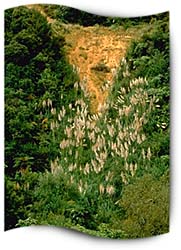|
Invasive weeds - Pampas Grass |
|
Invasive weeds - Pampas Grass |
What is it?
There are two species, Cortaderia selloana and Cortaderia jubata.
They are large, coarse leaved, grass-like bushes which grow up to
three metres in height. Care must be taken with identification as
exotic pampas grass can easily be mistaken for the native toetoe (our
school emblem), of which there are four species.
Key differences are the following:
* Pampas leaves have a conspicuous midrib, but lack distinct secondary veins between the midrib and leaf edge. Toetoe leaves have distinct secondary veins between the midrib and leaf edge.
* Pampas leaves snap readily when given a sharp tug. Toetoe leaves do not snap easily.
* Toetoe leaf sheaths, at the base of the flowering stems, have a white waxy surface. Pampas leaf sheaths do not have a white waxy surface.
* Dead pampas leaves hang down and form spirals. Mature plants are often surrounded by these dead leaves, which look like wood shavings. Toetoe leaves droop down, but do not form spirals.
* Pampas flower heads are erect (stand upright) and dense, and range in colour from white to purple. Cortaderia jubata begins flowering in late January, and Cortaderia selloana begins flowering in early March. Toetoe flowers from October to January, and the flowers are thinner and more drooping.

Why is it a problem?
Pampas threatens the productivity of plantation forests and land of
high conservation value. It has the ability to reach distant open
spaces quickly and to blanket them with very rapid growth. Native
turfland communities can be quickly overcome by the invasion of
pampas.
Pampas invades disturbed areas such as cleared bush margins, burned areas and firebreaks where it competes with and smothers other vegetation, and provides a habitat for rats and mice. The buildup of dry material from pampas such as dead leaves, leaf bases and flowering stalks makes a significant fire risk.

Methods of control
Manual Control: Digging and grubbing is possible for seedlings
and small plants. It is possible to chainsaw smaller plants and to
remove sizeable plants by bulldozer. Chainsawing and slashing can be
combined with chemical spraying of regrowth.
Grazing is not recommended as pampas is likely to be ignored by animals in favour of the more palatable toetoe.
Chemical Control: Spray should be applied from spring to autumn, or after flowering. The common herbicides that are suitable include Roundup and Gallant. Use the concentrations recommended by the manufacturer. Take care to spray only in still conditions to avoid wind drift to non-target plants and don't spray when rain is expected.
During spraying, non-target plants can be shielded with cardboard, plastic sheets or a large plastic container.
The use of a marker dye helps to avoid double spraying and wastage, and a foaming agent can be added to the spray to help prevent spray drift.
Make sure you leave the plants in the ground until the roots have died off. Do not re-apply herbicide too soon after the initial treatment. Wait until the plant actively begins growing again.
As with all spraying you should read the instructions on the manufacturer's label closely and always wear protective clothing.
1. Make a chart showing how to identify
toetoe and pampas grass. Draw a diagram to show the
respective midribs and secondary veins on the
leaves. .
![]() FOLLOWUP
FOLLOWUP